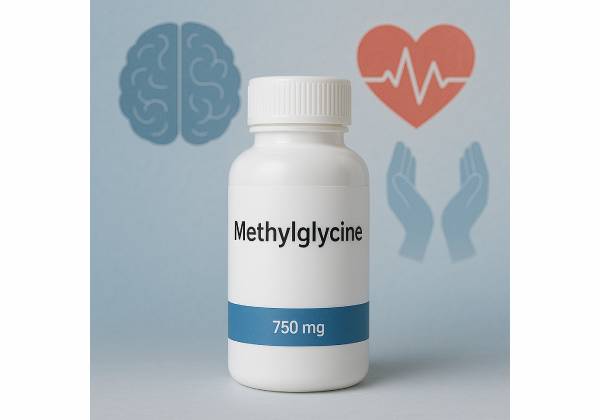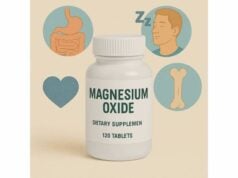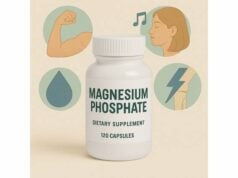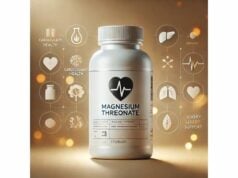
Methylglycine—better known as sarcosine—is a naturally occurring amino acid derivative (N-methylglycine) formed when a single methyl group is added to glycine. Inside the body, it sits at a crossroads of methylation, creatine synthesis, and one-carbon metabolism through the enzyme glycine N-methyltransferase (GNMT). In nutrition and wellness circles, sarcosine is discussed for three main reasons: its role in cellular methyl balance, emerging psychiatric research (especially as an adjunct in schizophrenia and, more recently, major depression), and its appearance in the literature as a candidate biomarker of prostate cancer in urine and serum. Unlike trendier compounds, sarcosine has decades of basic science behind it and a handful of controlled clinical trials—yet much of the public conversation mixes promising signals with overreach. This guide unpacks what methylglycine actually does, who might benefit, how to take it (if appropriate), the pitfalls to avoid, and what the evidence says today so you can weigh potential advantages against risks with a clear, practical frame.
Quick Overview
- Acts at the NMDA receptor pathway (via glycine transporter-1 inhibition) and participates in methylation through GNMT.
- Studied doses in adults range from 1–2 g/day (adjunct for schizophrenia or depression) with generally good tolerability.
- Evidence is adjunctive, not curative: benefits appear most consistent in schizophrenia without clozapine; depression data are early.
- Biomarker status for prostate cancer is investigational; not a stand-alone screening test.
- Avoid self-use if pregnant, on clozapine or interacting NMDA-modulating regimens, or if you have significant renal disease—seek clinician guidance.
Table of Contents
- What it is and how it works
- Benefits: what it actually helps
- Who should consider it and when
- How to take it: dosing and timing
- Common mistakes, side effects, and interactions
- Evidence, FAQs, and practical takeaways
What it is and how it works
Names and basics. Methylglycine is the chemical name; sarcosine is the common name used in research and on many supplement labels. Biochemically, it’s glycine with one methyl group attached (N-methylglycine). Your body both makes and uses sarcosine daily. Two enzymes anchor its traffic:
- GNMT (glycine N-methyltransferase) converts glycine + S-adenosylmethionine (SAM) → sarcosine + S-adenosylhomocysteine (SAH). This step buffers methyl group supply and demand, linking sarcosine to global methylation status.
- SARDH (sarcosine dehydrogenase) converts sarcosine back toward glycine, shuttling one-carbon units into folate cycles. Through these reversible steps, sarcosine participates in methyl balance, creatine synthesis (via guanidinoacetate methylation), and energy pathways.
In the brain. Sarcosine also inhibits glycine transporter-1 (GlyT-1) on glial cells. By slowing glycine reuptake in the synaptic cleft, sarcosine increases local glycine availability at the NMDA receptor’s glycine co-agonist site. NMDA receptor function, especially on inhibitory GABA interneurons, is integral to cortical signaling and cognitive processes. This mechanism explains interest in sarcosine as an adjunctive therapy for schizophrenia (to improve negative symptoms and overall severity in some contexts) and as a candidate add-on in major depressive disorder. Sarcosine is not a sedative, stimulant, or classic nootropic; its effects run through glutamatergic modulation and are sensitive to dose and co-medications.
In oncology diagnostics. Metabolomics studies over the past 15 years linked sarcosine and related enzymes (GNMT, SARDH) to prostate cancer biology. Some cohorts found higher serum or urinary sarcosine in men with prostate cancer versus benign conditions, while others reported mixed or null findings, especially for aggressive disease. Today, sarcosine is best viewed as a research biomarker—a piece of a larger risk picture rather than a definitive screening tool.
Kinetics and forms. Sarcosine is water-soluble and orally bioavailable. In trials, 1–2 g/day split once or twice daily was common. Peak levels typically occur in a few hours; a steady effect on NMDA pathways depends on consistent daily use. Over-the-counter powders and capsules are widely available; quality varies, so third-party testing matters.
Why naming matters. Marketing sometimes calls sarcosine “N-methylglycine,” “methylglycine,” or lists it as part of “methyl donors.” While it does interface with methyl metabolism, its clinical effects in psychiatry arise from glycine transport and NMDA co-agonism, not simply “adding methyls.” Keeping those roles distinct helps prevent dosing mistakes and unrealistic expectations.
Benefits: what it actually helps
Schizophrenia (adjunctive use).
The most studied application of sarcosine is as an add-on to antipsychotic medication. Randomized controlled trials have reported symptom improvements—particularly for negative symptoms and global severity—when 2 g/day sarcosine was added to stable antipsychotic regimens. Effects vary with the background antipsychotic: benefits appear more consistent when patients are not on clozapine, and more mixed when clozapine is present. Trial durations often ran 6–12 weeks; responses typically emerged by week 6 in responders. Tolerability was generally good, with mild GI upset or activation in a minority. To interpret this evidence correctly:
- Sarcosine does not replace antipsychotics.
- It may modestly improve certain symptom domains for a subset of patients, especially those with chronic, non-refractory illness on non-clozapine agents.
- Benefits depend on dose fidelity (close to 2 g/day) and adherence alongside routine care.
Major depression (investigational adjunct).
Small controlled studies and emerging trials suggest that adding sarcosine to an SSRI may improve depressive symptoms over 8 weeks, potentially via NMDA modulation coupled to downstream neurotrophic and glycinergic changes. This is early-stage evidence—not a standard of care. If pursued, it should be supervised by a clinician who can monitor mood scales, sleep, and activation or anxiety, adjusting background therapy as needed.
Cognition in healthy adults (limited).
Despite its mechanistic appeal, high-quality trials in healthy people are scarce. Claims of broad memory or attention enhancement outpace the evidence. If cognitive benefit exists in healthy users, it’s likely subtle, task-specific, and dose-dependent, not a dramatic universal effect.
Metabolic or “methylation” support (contextual).
Because GNMT uses SAM to form sarcosine, you’ll see sarcosine grouped with “methyl donors.” In practice, nutritional strategies that secure folate, B12, choline, and betaine alongside balanced protein typically address methyl group needs. Sarcosine is a participant, not a universal fix for methylation complaints. Using it as a standalone “methyl booster” is conceptually oversimplified.
Prostate cancer biomarker (research stage).
Urinary and serum sarcosine have been explored as components of multianalyte panels to help differentiate benign disease from prostate cancer or to stratify risk. Results across studies are heterogeneous. Sarcosine alone is not reliable enough to guide biopsy decisions without standard markers (PSA, DRE, imaging) and clinical context. At best, it’s an adjunct signal under investigation in diagnostics research.
Bottom line on benefits.
- Strongest clinical signal: adjunct in schizophrenia (especially non-clozapine settings) at 2 g/day.
- Promising but early: adjunct in major depression.
- Unproven for general cognition; not a stand-alone biomarker for prostate cancer screening.
- Any use should align with clear goals, a time-boxed trial, and medical oversight when psychiatric conditions are involved.
Who should consider it and when
Most appropriate candidates
- Adults with schizophrenia on a stable non-clozapine antipsychotic who continue to have negative symptoms or persistent global impairment despite adherence. Here, a clinician-directed, time-limited trial of sarcosine 2 g/day may be reasonable.
- Adults with major depressive disorder who are on an SSRI with only partial response and are interested in a research-informed adjunct under medical supervision.
- People engaged in oncology research or clinical studies involving metabolomic biomarkers of prostate cancer. For patients, sarcosine testing—if offered—should be seen as exploratory rather than diagnostic.
People who should approach with caution or avoid self-use
- Clozapine-treated patients: the add-on signal is weaker and may be inconsistent; changes to regimens that include clozapine should always be specialist-directed.
- Pregnant or breastfeeding individuals: safety data are insufficient; avoid unless part of a study with appropriate oversight.
- Significant renal impairment: amino acid derivatives may accumulate; dosing and monitoring require clinician input.
- History of pronounced activation or insomnia with NMDA-modulating agents: titration and timing matter; some will not tolerate sarcosine.
- Those seeking “methylation cures.” If you suspect a methylation issue, start with a comprehensive approach (dietary folate, B12, choline/betaine, overall protein adequacy) rather than isolating sarcosine.
Good-fit scenarios with examples
- Persistent negative symptoms: A patient stabilized on a second-generation antipsychotic still struggles with social withdrawal and blunted affect. After reviewing meds and adherence, the psychiatrist adds sarcosine 2 g/day for 8–12 weeks, tracks PANSS/negative subscale trends, and discontinues if no meaningful change emerges.
- Partial SSRI response: An adult with residual anergia and cognitive fog considers an adjunct. The clinician discusses options (exercise prescription, sleep timing, psychotherapy dose, medication strategies) and may add sarcosine short-term, with scheduled monitoring for activation or GI effects.
- Research participation: A urology team uses multianalyte urine panels—including sarcosine—as exploratory inputs alongside PSA and MRI to refine who needs biopsy, while making it clear that sarcosine is not a stand-alone test.
When it is probably not worth it
- You’re otherwise healthy and hoping for a general “nootropic lift.” Evidence is limited; basic pillars—sleep, physical activity, creatine (for low meat intake), omega-3s (for low fish intake)—have stronger backing.
- You have complex, poorly controlled psychiatric illness with frequent medication changes. Layering sarcosine atop an unstable regimen adds confounders and risks without clear benefit.
How to take it: dosing and timing
Forms and quality
- Available as powders or capsules labeled “sarcosine” or “N-methylglycine.” Choose products with third-party testing for identity, purity, and heavy metals.
- Sarcosine’s taste is mildly sweet; powders mix easily in water. If GI upset occurs, switch to capsules or take with food.
Evidence-aligned doses (adults)
- Schizophrenia adjunct: 2 g/day in one or two divided doses. Many trials used 2 g once daily; some clinicians split 1 g morning + 1 g early afternoon if activation or GI effects appear.
- Major depression adjunct: most data use 2 g/day alongside an SSRI for 8 weeks; this remains investigational and should be clinician-directed.
- General wellness/cognition: there is no established dose for healthy adults; routine use is not evidence-based.
Timing strategies
- Morning or early afternoon dosing helps minimize sleep disruption if you’re sensitive to activation.
- With food can blunt nausea in some users; others prefer an empty stomach for quicker onset.
- Consistency matters: daily intake over 6–8 weeks is a fair trial period to judge psychiatric adjunct effects.
What to monitor
- Subjective response using a brief weekly checklist: mood, motivation, social engagement, anxiety, sleep onset, GI comfort.
- Objective anchors in clinical care: standardized scales (PANSS, MADRS), attendance/functioning, and medication adherence.
- Side effects: restlessness, insomnia, nausea, loose stools; usually mild and transient. If persistent or distressing, reduce to 1 g/day or discontinue.
Stacking and combinations
- With folate/B12/choline/betaine: fine from a nutrition perspective, though not required for sarcosine’s NMDA mechanism.
- With other NMDA modulators (e.g., D-serine, glycine, ketamine pathways, high-dose magnesium): avoid DIY stacks; effects can be unpredictable. Any combination should be specialist-guided.
- With caffeine: many tolerate the combo, but if activation or anxiety increases, separate or reduce caffeine.
Trial-and-reassess plan
- Confirm clear goal (e.g., negative symptoms, residual depression).
- Choose 2 g/day as the default adult dose, adjust if needed for tolerability.
- Run a 6–8 week trial with scheduled check-ins.
- If no meaningful gain, stop. If helpful and well tolerated, discuss whether to continue, pause, or re-trial later.
Common mistakes, side effects, and interactions
Five common mistakes
- Expecting monotherapy results. Sarcosine is an adjunct, not a replacement for antipsychotics or antidepressants. Benefits depend on the background regimen and are not universal.
- Using it with clozapine and expecting the same effect. Trials suggest weaker or inconsistent benefits alongside clozapine. If clozapine is involved, any adjunct should be handled by the treating psychiatrist.
- Megadosing “for methylation.” Sarcosine participates in methyl cycles, but piling on grams solely to “fix methylation” misses the bigger picture (overall diet, folate/B12/choline status, liver and kidney health).
- Poor timing and sleep disruption. Taking sarcosine late in the day can contribute to insomnia or a “wired” feeling for sensitive users.
- Reading too much into a single biomarker. Elevated urinary or serum sarcosine does not diagnose prostate cancer and should not replace standard screening and shared decision-making.
Likely side effects (usually mild and short-lived)
- GI: nausea, loose stools, abdominal discomfort—often improved by food or dose-splitting.
- CNS: restlessness, activation, mild anxiety, or insomnia—more likely at higher total daily dose or in combination with stimulating agents.
- Headache or lightheadedness in a minority.
- Allergy is rare; discontinue and seek care if rash, swelling, or breathing difficulty occurs.
Notable interactions and cautions
- Clozapine: adjunct benefits appear limited; any changes require psychiatric oversight.
- Other NMDA-pathway agents: stacking with D-serine, high-dose glycine, ketamine-adjacent regimens, or investigational GlyT-1 inhibitors can produce unpredictable effects; avoid outside research/clinical protocols.
- Renal impairment: consider lower doses or avoidance; discuss with a physician.
- Pregnancy/lactation: insufficient safety data—avoid unless formally studied.
- Seizure history: while uncommon, shifts in excitatory neurotransmission warrant consultation with neurology/psychiatry before use.
- Oncology therapy: sarcosine’s role is diagnostic research, not therapy; supplements should not delay, replace, or complicate evidence-based cancer care.
When to stop immediately and call your clinician
- New or severe agitation, insomnia that doesn’t settle with earlier dosing, worsening psychosis, or suicidal thoughts.
- Persistent GI bleeding, severe abdominal pain, or signs of allergic reaction.
- Any sudden neurologic change (confusion, severe headache, focal weakness).
Evidence, FAQs, and practical takeaways
Is methylglycine the same as sarcosine?
Yes. “Methylglycine” describes the chemical structure; sarcosine is the common name. Labels may use either term; both refer to N-methylglycine.
How strong is the schizophrenia evidence?
Moderate: multiple controlled trials using 2 g/day as an add-on show modest improvements in some patients, especially without clozapine in the background. Effects tend to appear by week 6. It’s a reasonable, supervised adjunct—not a primary treatment.
Does it help depression?
Possibly, as an adjunct to SSRIs in some adults over ~8 weeks, but this remains emerging evidence. If considered, do it with a clinician who can monitor symptoms, sleep, and interactions.
What about using sarcosine to boost memory if I’m healthy?
There’s no high-quality evidence for broad cognitive enhancement in healthy adults. Focus on fundamentals with stronger data (sleep regularity, exercise, diet quality, creatine for low meat eaters, omega-3s for low fish intake).
Is sarcosine a proven prostate cancer test?
No. While sarcosine appears in research as a candidate biomarker, results are mixed across studies. It’s best regarded as experimental and adjunctive within multi-marker panels—not a replacement for PSA, examination, imaging, and shared decision-making.
What dose should I choose?
If your clinician recommends a psychiatric adjunct trial, 2 g/day is the most studied adult dose. Start with 1 g in the morning + 1 g midday to gauge tolerability. For anyone else, there is no established wellness dose.
What does success look like?
In psychiatric adjunct trials: small-to-moderate, functional improvements—more social engagement, better initiative—without destabilizing sleep or anxiety. Clinicians use standardized scales to judge benefit; if none by 6–8 weeks, discontinuation is appropriate.
Key takeaways you can act on now
- Treat sarcosine as a targeted adjunct with time-boxed expectations, not a cure-all.
- If you’re on clozapine or an NMDA-modulating regimen, do not add sarcosine without specialist input.
- For general health goals, prioritize sleep, movement, nutrition, and proven micronutrients before considering sarcosine.
- If exploring sarcosine under medical care, use 2 g/day, dose earlier in the day, track sleep and activation, and reassess at week 6–8.
- Don’t use sarcosine (or any single biomarker) to make cancer decisions in isolation.
References
- Sarcosine as an add-on treatment to antipsychotic medication for people with schizophrenia: a systematic review and meta-analysis of randomized controlled trials 2021 (Systematic Review)
- Sarcosine (N-methylglycine) treatment for acute schizophrenia: a randomized, double-blind study 2008 (RCT)
- PI3K-regulated Glycine N-methyltransferase is required for the development of prostate cancer 2022 (Mechanistic/Oncogenesis)
- Point-of-care diagnostics for rapid determination of prostate cancer biomarker sarcosine in urine 2023 (Review)
- Prospective evaluation of serum sarcosine and risk of prostate cancer in the Prostate, Lung, Colorectal, and Ovarian Cancer Screening Trial 2013 (Prospective Study)
Medical Disclaimer
This article is for educational purposes and does not replace personalized medical advice, diagnosis, or treatment. Methylglycine (sarcosine) is not a stand-alone therapy for psychiatric or oncologic conditions. Do not start, stop, or combine sarcosine with prescription medications—especially clozapine or other NMDA-modulating agents—without guidance from a qualified clinician. If you experience new agitation, insomnia, worsening mood or psychosis, allergic symptoms, or any concerning side effects, stop the supplement and seek medical care promptly.
If you found this guide helpful, please consider sharing it on Facebook, X (formerly Twitter), or your preferred platform, and follow us for future evidence-based updates. Your support helps us continue creating high-quality, reader-first health content.










